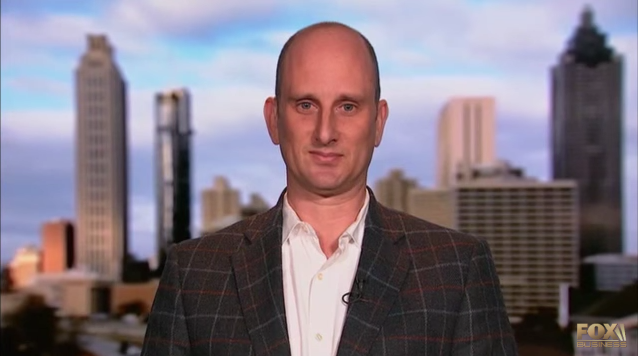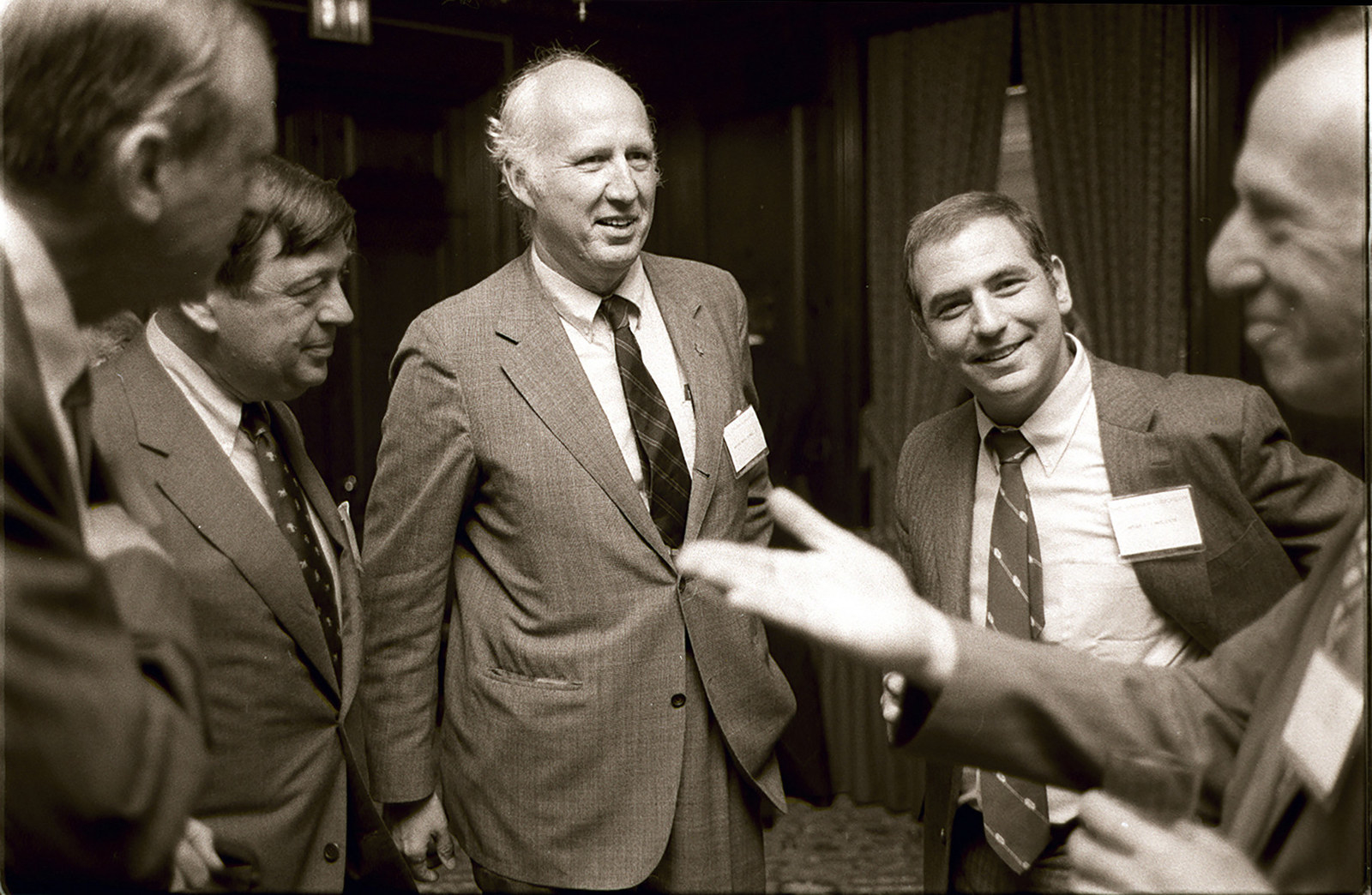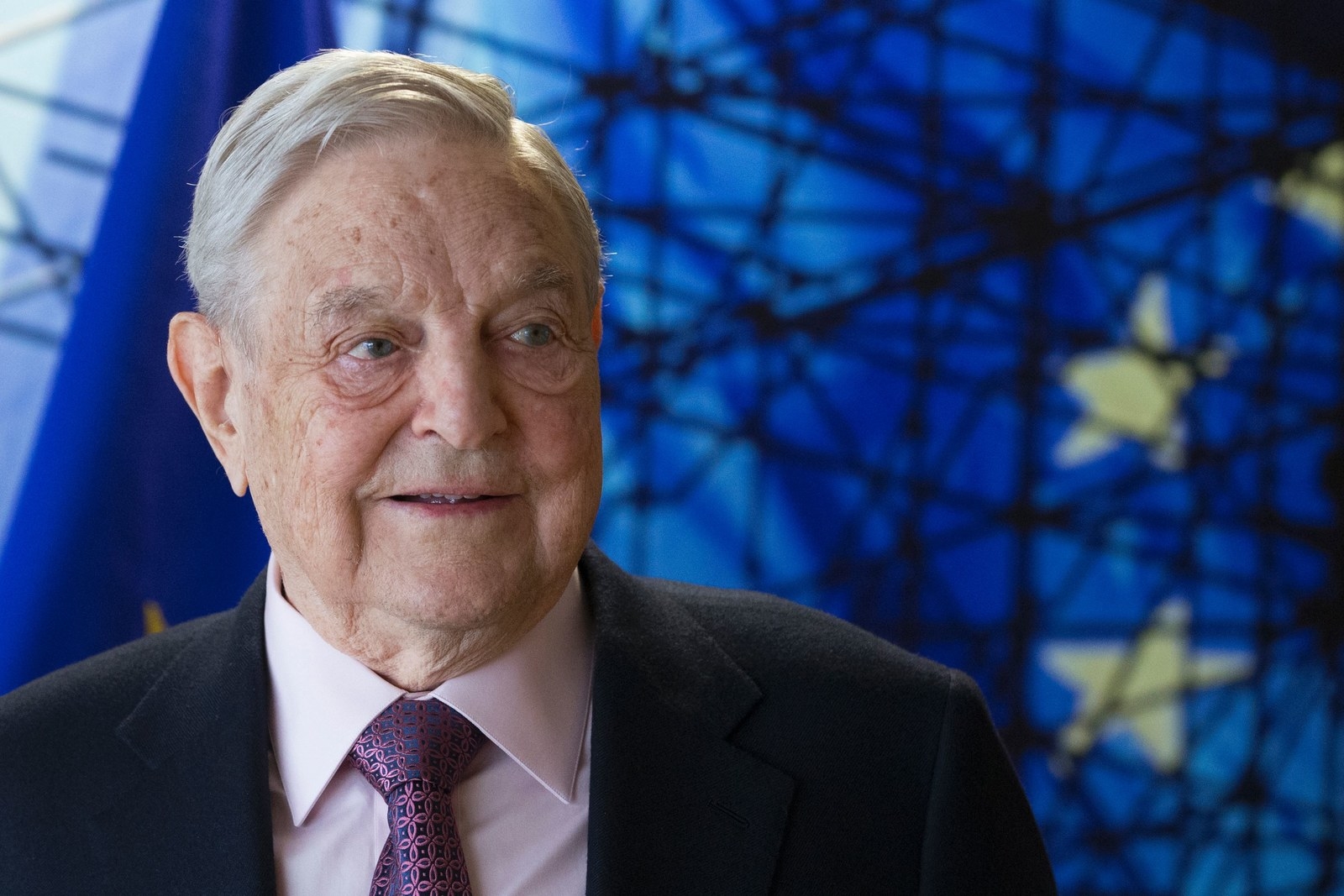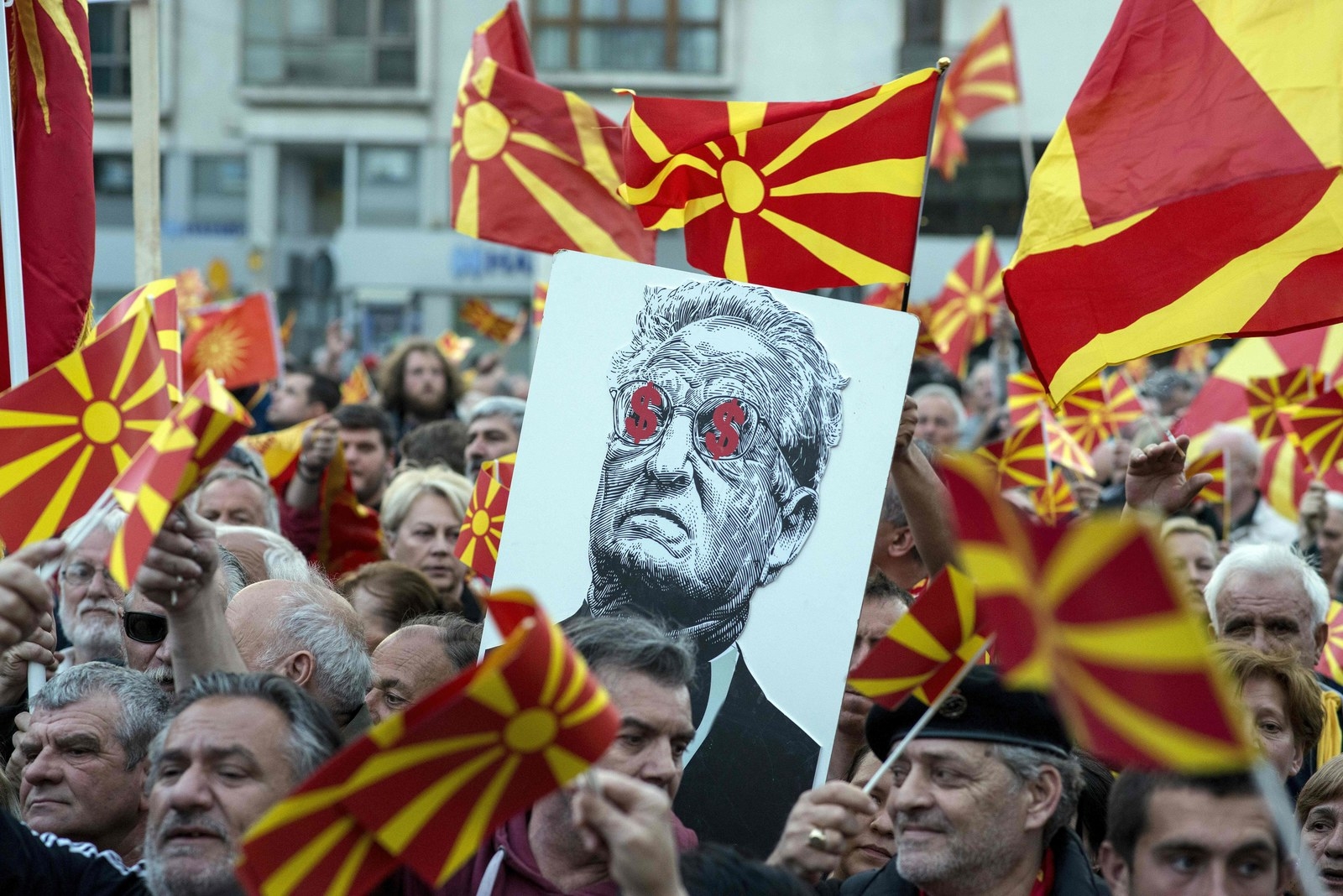The glass tower that houses George Soros’s office in Manhattan is overflowing with numbers on screens, tracking and predicting the directions of markets around the world. But there’s one that’s particularly hard to figure out — a basic orange chart on a screen analyzing sentiment on social media.
The data, updated regularly since 2017, projects the reactions on the internet to the name George Soros. He gets tens of thousands of mentions per week — almost always negative, some of it obviously driven by networks of bots. Soros is pure evil. A drug smuggler. Profiteer. Extremist. Conspiracist. Nazi. Jew. It’s a display of pure hate.
The demonization of Soros is one of the defining features of contemporary global politics, and it is, with a couple of exceptions, a pack of lies. Soros is indeed Jewish. He was an aggressive currency trader. He has backed Democrats in the US and Karl Popper’s notion of an “open society” in the former communist bloc. But the many wild and proliferating theories, which include the suggestion that he helped bring down the Soviet Union in order to clear a path to Europe for Africans and Arabs, are so crazy as to be laughable — if they weren’t so virulent.
Soros and his aides have spent long hours wondering: Where did this all come from?
Only a handful of people know the answer.
On a sunny morning last summer, one of them could be found standing in front of the huge buffet in the Westin Grand Hotel in Berlin. George Birnbaum is built like a marathon runner — tall and slender, his head and face shaved clean. Elegant horn-rimmed glasses frame his piercing blue eyes.
Birnbaum — a political consultant who has worked in the US, Israel, Hungary, and across the Balkans — had agreed to talk for the first time about his role in the creation of the Soros bogeyman, which ended up unleashing a global wave of anti-Semitic attacks on the billionaire investor. But he also wanted to defend his work, and that of his former mentor and friend, Arthur Finkelstein.
George Eli Birnbaum was born in 1970 in Los Angeles, where his family moved after fleeing Nazi Germany. His grandfather was shot by the Nazis in front of his son, Birnbaum’s father, who later survived Auschwitz. Anti-Semitism followed the family as they moved to Atlanta, where Birnbaum grew up, and where the Jewish school he attended was often defaced with anti-Semitic slurs. It left a mark.
In an era when many American Jews drifted away from their specific identity, Birnbaum wasn’t allowed to forget it. Every weekend his father handed him the Jerusalem Post.
“First you learn what’s going on with the Jewish people in the world, then you can worry about the rest of the world.”
“First you learn what’s going on with the Jewish people in the world, then you can worry about the rest of the world,” Birnbaum remembered his father saying. He grew up believing that only a strong nation, the state of Israel, could protect the Jews from a second Holocaust.
All of which makes it bizarre that Birnbaum and Finkelstein’s ideas spawned a new wave of anti-Semitism, and that they did so in the service of an authoritarian leader, Hungarian Prime Minister Viktor Orbán, reviled around the world for his far-right views. The two men took all the arguments against Soros, from East and West, from left and right, and fused them together. Two American Jews, one a towering figure in US politics, helped create a monster.
Birnbaum doesn’t appreciate the irony, but there is little doubt he played a crucial role in the weaponizing of anti-Semitism.
And he did it by putting Soros on the chopping block.
Starting in 2008, Birnbaum and Finkelstein worked in secret to get Orbán elected. Their victory in Hungary — away from the intense political scrutiny of Western Europe — showed that constructing an external enemy could bring electoral success in the modern era. It allowed Hungary to give birth to “Trump before Trump,” as Steve Bannon said.
Birnbaum and Finkelstein’s work has provided a new model for attack politics in this era of global division. They designed a master plan for exploiting these divisions that has worked in many different countries and contexts, and helped create a Jewish enemy that the far right has exploited to devastating effect. In 2016, when Trump ran his final TV ad ahead of the election, it came as no surprise that Soros was featured as a member of “global special interests” who don’t have “your good in mind.”
Want to support more reporting like this? Become a BuzzFeed News member today.

To understand Birnbaum, you have to look backward, through the brutal Israeli politics of the 1990s to Washington, DC, in the 1970s, where a new profession known as political consultancy was devising a fresh set of tools for bringing people to power. There you find Birnbaum’s spiritual father, Finkelstein.
Starting in the late 1960s, Finkelstein was one of a handful of men reinventing the industry of political consulting in New York. He would go on to help presidents and senators, to pioneer a slashing style of television advertising, and to build a generation of protégés.
Finkelstein isn’t as famous as his contemporary Roger Ailes, but he is a hidden link that runs through the contemporary Republican Party, leading from the libertarian icon Ayn Rand to the cynicism of Richard Nixon and finally on to Trump. Finkelstein was a New York City kid. The son of a cab driver, he met Rand while he was a student at Columbia University in the early 1960s. He went on to work briefly as a computer programmer on Wall Street before becoming an early exponent of the art of polling toward the end of the decade.

It was back then that Finkelstein started developing a political method that now reads like a how-to guide for modern right-wing populism. Finkelstein’s premise was simple: Every election is decided before it even begins. Most people know who they will vote for, what they support, and what they oppose. It’s very difficult to convince them otherwise, Finkelstein believed. It’s a lot easier to demoralize people than to motivate them. And the best way to win is to demoralize your opponent’s supporters. That’s what Trump did to great effect against Hillary Clinton, and what he meant when, after the election, he thanked black Americans for not voting.
Finkelstein had long been studying the big political trends, and he settled on simple issues that could do the most damage. In the end, he noticed, it usually comes down to the same concerns: drugs, crime, and race. These are the issues that create the most political division, he wrote in a memo to the Nixon White House in 1970.
Finkelstein’s goal was to polarize the electorate as much as possible, to pitch each side against the other. The fuel: fear. “The danger has to be presented as coming from the Left,” a 25-year-old Finkelstein advised Nixon.
Whoever doesn’t attack first will be beaten, he argued. And Finkelstein made things personal. Every campaign needs an enemy to defeat. He developed negative campaigning into a technique he called “rejectionist voting” — to demonize the enemy so much that even the laziest of voters would want to get out and vote, just to reject them.
In TV campaigns opponents were branded as “ultra liberal,” “crazy liberal,” “embarrassingly liberal,” or “too liberal for too long.”
Finkelstein would also advise his clients not to talk about themselves, but instead to focus their campaigning on destroying their opponents. He became notorious for turning “liberal” into a dirty word. In TV campaigns that no 1990s American could avoid, opponents were branded as “ultra liberal,” “crazy liberal,” “embarrassingly liberal,” or “too liberal for too long.” Campaigners named his ideology “Finkel-Think.” It was simple but effective. Friends of Finkelstein have often claimed that nobody got more politicians elected than he did.
Controversy occasionally surrounded his work. In the 1980s, while working for a Republican candidate, he was criticized for polling voters to see what they thought of the Jewish identity of his Democrat opponent.
By the time of his death in 2017, Finkelstein had left an indelible mark on national politics, having worked for Barry Goldwater, Richard Nixon, and Ronald Reagan. While working as a central campaign member for Reagan in 1980, a strangely gloomy advertisement appeared: “Let’s make America great again.”
He reportedly did some work for the Trump Organization in the mid-2000s — and later spoke of the “mind-boggling” power of Trump’s personality. When Trump finally ran for president, his campaign was stuffed with “Arthur’s kids” and friends: Larry Weitzner, Tony Fabrizio, and his old buddy Roger Stone.
Birnbaum was one of Arthur’s kids. After graduating from Florida Tech in the early ’90s, he first came into Finkelstein’s orbit in DC when the latter was working at the National Republican Senatorial Committee. It was Birnbaum’s job to bring Finkelstein the latest polling numbers each morning. Everything Finkelstein did was based on analysis of his polls, Birnbaum remembered, who said no one could see the patterns like Finkelstein.
Birnbaum was blown away by Finkelstein’s brain, and his insights. But he also discovered the other Arthur.
To the outside world, Finkelstein was an enigma, the strategist who worked for the right. But in private he was a friendly, fun, brilliant, and yet unpretentious man, full of anecdotes from the innermost circles of power. Raised in a Jewish family in Queens, he made jokes about kosher rules. He was a nerd with the chest pocket of his blue button-down shirt full of pens and notes.
In the otherwise stuffy world of politics, Finkelstein kept his tie loose and could often be seen walking around the office in his socks. He could do that because he was seen as the right half of the right’s brain. Finkelstein once told a friend that Reagan’s chief of staff thanked him in writing for “keeping your shoes on most of the time” while in the Oval Office. Finkelstein’s passion was elections. Politics reminded him, he told students in Prague, of “waves on a beach that look alike, but over time are always different.” His love, however, was for his two daughters — and for a man. Finkelstein, who helped get radical Republican gay-haters elected, was gay. He married his partner of more than 40 years in 2004, and they were together until Finkelstein’s death.
A year after Birnbaum first met Finkelstein, he bumped into him again in an anonymous hallway of the NRSC. He told him that he wanted to work for him, to do polling for him. And he spoke Hebrew, too, if he would ever have a project in Israel.

The assassination of the Israeli prime minister, Yitzhak Rabin, on Nov. 4, 1995, was a turning point for the country — and for Finkelstein and Birnbaum.
When elections for his successor were hastily arranged, a newcomer threw his hat into the ring. Benjamin Netanyahu, a right-wing former corporate consultant, was given no chance. He was running against Shimon Peres, a legendary figure, a Social Democrat from the founding generation of Israel who wanted to continue Rabin’s peace process, which most people hoped would succeed.
Israelis initially sneered at Netanyahu’s ambitions, and polls put him 20% behind. But seemingly out of nowhere, Netanyahu’s Likud party started carpeting the country with sinister ads. “Peres will divide Jerusalem” went the slogan, even though Peres had no such intention. Similar attacks targeting Peres appeared on TV, on the radio, and in the press.
In the final TV debate, Peres stepped into the trap laid by Finkelstein. The first thing he did was to try to clarify that he had no desire to divide Jerusalem — the exact topic Finkelstein wanted him to raise. Netanyahu owned the debate.
On Election Day, the race between Peres and Netanyahu looked too close to call. Around 10 p.m. the TV stations reported a very close win for Peres, based on early projections. According to a biography of Netanyahu, he grabbed the phone and called “Arthur” — his secret campaign manager. Finkelstein was in New York, but answered immediately, and told Netanyahu he shouldn’t be worried. “I always win the close ones.”
When the final count came in, Netanyahu was the new prime minister: 50.49% to 49.51%.
“Arthur always said that you did not fight against the Nazis but against Adolf Hitler. Not against al-Qaeda, but against Osama bin Laden.”
Netanyahu’s win made Finkelstein a star. He “changed campaigning forever,” according to the Haaretz newspaper. He had learned too that his formula could work outside North America. Finkelstein’s expertise became much sought after.
In 1998 Birnbaum received a call. It was Finkelstein, asking whether he would like to work for the Likud party in Israel, a dream come true for Birnbaum. It was here that the two became a team, with Finkelstein as captain and Birnbaum his first mate. While Finkelstein traveled between New York and Israel, Birnbaum kept watch in Israel, where he became the chief of staff for Netanyahu, organizing his appearances, representing him in front of the press, and sometimes even babysitting his kids.
The triumph in Israel marked the beginning of a new era. It was then that Finkelstein turned to Europe, and an even closer collaboration with Birnbaum. From 2003 onward, the two men worked together as global political consultants, applying Finkelstein’s formula to Eastern Europe and the Balkans, starting with successful election campaigns in Romania and Bulgaria.

Finkelstein and Birnbaum’s electoral masterpiece was created in Hungary, and would have implications around the world.
It began in 2008, when Orbán decided to seek reelection. His old friend Bibi — as Netanyahu is known — introduced him to the two people who would guide his success. Before long, Finkelstein and Birnbaum were applying their formula to Orbán’s election campaign — and then turbocharging it.
Enemies were easy to find in Hungary. The country was an economic basket case and had to be bailed out in 2008. Austerity measures were demanded by their creditors at the World Bank, the EU, and the IMF. Finkelstein and Birnbaum told Orbán to target “the bureaucrats” and “foreign capital.”
Orbán won the 2010 election with a two-thirds majority as the country shifted to the right. Birnbaum is still amazed today how easy it was: “We blew the Socialist party off the table even before the election.”
“You need to keep the base energized, make sure that on Election Day they have a reason to go out and vote.”
Birnbaum and Finkelstein, now part of Orbán’s inner circle, found themselves with a problem. While the satisfied winner of the election started rewriting the constitution, they were now lacking an opponent. “There was no real political enemy … there was no one to have a fight with,” Birnbaum remembered. The ultra-right Jobbik party and the Socialist party were beaten, the rest in splinters. “We had had an incumbent with a historic majority, something that had never happened in Hungary before.” To maintain that, they needed a “high energy level,” said Birnbaum. “You need to keep the base energized, make sure that on Election Day they have a reason to go out and vote,” he said. They needed something powerful, like Trump’s “Build the Wall!”
“It always helps rally the troops and rally a population” when the enemy has a face, Birnbaum explained. “Arthur always said that you did not fight against the Nazis but against Adolf Hitler. Not against al-Qaeda, but against Osama bin Laden.” Who could become that enemy in Hungary now that Orbán was in power — and wanted to stay there?
Orbán was busy creating a new, more dramatic story of the nation. Hungary, which had collaborated with the Nazis, was painted as a victim, surrounded by external enemies, under perpetual siege, first from the Ottomans, then the Nazis, and later the Communists. Hungary’s mission was clear: to defend against its enemies, and to preserve Christianity against encroaching Islam and secular forces.
Against this backdrop, Finkelstein had an epiphany. What if the veil of the conspiracy were to be lifted and a shadowy figure appear, controlling everything? The puppet master. Someone who not only controlled the “big capital” but embodied it. A real person. A Hungarian. Strange, yet familiar.
That person was Soros, Finkelstein told Birnbaum.
Birnbaum was mesmerized: Soros was the perfect enemy.
At the beginning, it almost didn’t make sense. Why campaign against a nonpolitician? Although he was born in Hungary, Soros hadn’t lived there in years. He was an old man, known all over the country as a patron of civil society. He had supported the opposition against the Communists before the fall of the Iron Curtain, and financed school meals for kids afterward. In Budapest, he had built one of the best universities in Eastern Europe.

Orbán had even received money from Soros: During his time in the opposition, his small underground foundation Századvég published critical newspapers, created on a copy machine that was paid for by Soros. Orbán was also one of the more than 15,000 students who received scholarships from Soros’s Open Society Foundations. Thanks to Soros, Orbán studied philosophy in Oxford. The two men only met once: when Soros came to Hungary in 2010 after a toxic spill to provide $1 million in emergency funds.
There didn’t really seem to be a reason to turn against him in Hungary.
But Finkelstein and Birnbaum saw something in Soros that would make him the perfect enemy. There’s a long history of criticism of Soros, dating back to 1992, when Soros earned $1 billion overnight betting against the British pound. For many on the left, Soros was a vulture. But Soros used his sudden prominence to push for liberal ideas. He supported everything the right was against: climate protection, equality, the Clintons. He opposed the second Iraq War in 2003, even comparing George W. Bush to the Nazis, and became a major donor for the Democrats. He was soon a hate figure for the Republicans.
But there was more. Finkelstein and Birnbaum had expanded their work into exactly those countries where the Open Society Foundations was trying to build liberal local elites and civil rights movements: Ukraine, Romania, the Czech Republic, Macedonia, Albania. Birnbaum believed Soros stood for “a socialism that is wrong for these areas.” According to Birnbaum, Finkelstein was more practical about his opposition to Soros, whom he saw as simply a means to an end: “It wasn’t an emotional thing.”
It didn’t take much for the two consultants to convince Orbán to take on Soros — the Hungarian prime minister had “an enormous amount of trust in Arthur’s intellect,” said Birnbaum. The anti-Soros campaign was useful for Orbán — and not just domestically. Externally, it would please his Russian neighbors. Putin was afraid of the so-called color revolutions like the one in Ukraine, and the Arab Spring, and had begun attacking Soros and his support for liberal causes.
The two men’s work for Orbán is now part of Hungary’s political legend. Finkelstein is an almost mythical figure, not least because Orbán has barely mentioned his role in public. His spokespeople did not reply to requests for comment about Finkelstein and Birnbaum.
Birnbaum was similarly unforthcoming about the exact details of the work they did for Orbán. He didn’t want to discuss whether they had drafted slogans or just simple concepts, nor would he say how much control they had over the campaign itself.
The public campaign against Soros began in earnest on Aug. 14, 2013, around nine months ahead of the next election. It started relatively quietly, with an article in the government-aligned newspaper Heti Válasz attacking NGOs that were said to be controlled by Soros.
Next, the Hungarian government went after the allegedly Soros-controlled environmental organization Ökotárs, which received Norwegian and Swiss funding. Police stormed their offices and confiscated computers, while the government opened an investigation into their activities. The Hungarian investigators would eventually come up empty — but not before they had succeeded in spreading the image of a shadowy network of foreign NGOs run by Soros.
“The perfect enemy is one that you can punch again and again and he won't punch back.”
Orbán and his team didn’t stop there. By 2015, the European refugee crisis, in part stimulated by the war in Syria, had emboldened nationalists across the continent. So when Soros argued that the EU needed to develop a “common plan” for the treatment of refugees, and prepare for a million asylum-seekers per year, he became a welcome target once more for Orbán’s team. On Oct. 30, 2015, Orbán made a speech in which he claimed Soros wanted to weaken the country and flood it with refugees.
The attacks came thick and fast after that. Any organization that had ever received money from the Open Society Foundations was painted as “Soros controlled.” Employees of the NGOs were described by government press as “mercenaries,” financed by foreign powers. All of that was done through a series of sensational articles and official responses from members of government.
A crescendo was reached in July 2017, when the whole country was plastered with ads showing Soros’s face and the slogan “Don’t let George Soros have the last laugh!”
The slogan “Stop Soros” was repeated endlessly, everywhere. Manipulated photos showed him walking hand in hand with allies through a fence: Orbán’s fence, constructed to stop refugees crossing into Hungary. Orbán claimed Soros maintained a mafia network.
In the fall of 2017 the administration conducted a “national consultation.” Millions of citizens received questionnaires, in which they could choose whether or not they supported the “Soros plan” to allow a million people from Africa and the Middle East to enter Europe per year.
It worked. A huge part of the country turned against Soros. Orbán won in 2014 and 2018, both times with an overwhelming majority.
Soros was trapped. “The perfect enemy is one that you can punch again and again and he won't punch back,” said Birnbaum. If Soros had struck back, it would have just played into their hands, confirming that he had power and influence, said Birnbaum. Soros and the Open Society Foundations have tried to counter accusations and attacks, and have even sued the Hungarian government in the European Court of Human Rights, but they couldn’t enter the political arena. It would be unthinkable for the 87-year-old Soros to run against Orbán. “Mr. Soros is not a politician,” said his assistant Michael Vachon.
Despite everything that followed, Birnbaum is proud of the campaign against Soros: “Soros was a perfect enemy. It was so obvious. It was the simplest of all products, you just had to pack it and market it.”
The product was so good, it sold itself and went global. In 2017, Italians started talking about Soros-financed immigrant boats arriving on the shores. In the US, some people suspected Soros was behind the migrant caravan entering from Central America. A Polish member of parliament called Soros the “most dangerous man in the world.” Putin referred dismissively to Soros during a press conference with Trump in Helsinki. Trump even claimed that the demonstrations against Supreme Court candidate Brett Kavanaugh were sponsored by Soros.
Today Finkelstein and Birnbaum’s work in Hungary has echoes everywhere. Birnbaum denied the suggestion that he had run anti-Soros campaigns outside of Hungary. But perhaps he didn’t have to. Anyone could pick up the ideas and run with them. Finkelstein and Birnbaum had turned Soros into a meme. Right-wing sites like Breitbart, or the Kremlin-controlled Russia Today, could simply adopt the Hungarian campaign, translate it into other languages, and feed it with local arguments.
If right-wing movements want to campaign today, they can source Soros material from the internet. Anti-Soros material is a globalized, freely available, and adaptable open-source weapon. Birnbaum said it was the common denominator of the nationalist movement.

Orbán’s campaign against Soros never actually used the word Jew, but it was often implicit. Orbán told his people they would have to fight against an “enemy” who was “different,” who didn’t have a “home.” It was common to see anti-Semitic graffiti on the “Stop Soros” ads — voters knew what they were being told.
Finkelstein and Birnbaum created a Frankenstein monster that found a new life on the internet. In that stew are the resentments for his assault on communism, and allegations that he’s a communist; anti-Jewish slurs and charges he’s a Nazi; and above all the old mix of European anti-Semitism.
If you search today for Soros, you will immediately find images of his head with octopus tentacles, another classic anti-Semitic motif. Even Netanyahu’s son Yair posted an anti-Semitic meme in 2017 showing Soros and reptilians controlling the world.
“Our campaign did not make anyone anti-Semitic who wasn’t before. Maybe we were just drawing a new target, not more. I would do it again.”
Members of the Jewish community in Hungary began to protest the Stop Soros campaign in 2017. The Israeli ambassador condemned it. When Zoltan Radnoti, a prominent Hungarian rabbi, learned that the campaign was led by two members of the Jewish community, he was shocked.
The anti-Semitism that sprang out of the Soros campaign might not be too surprising, even if Finkelstein and Birnbaum did not intend it. They imported ancient themes and modern grievances into 21st-century communications technology. What was new: They had turned Soros into their central political enemy.
The allegation that he was responsible for anti-Semitism pains Birnbaum. He just doesn’t see it. He decided to speak primarily because he wants to refute it. He is, after all, an observant Jew and member of many pro-Israeli charities.
“When we planned the campaign,” he said, “we didn’t think a second about Soros being a Jew.” Birnbaum claimed he didn’t even know it back then, and that he never worked with anti-Semites.
Before working with Orbán, he checked in with informed circles in Israel to see how Orbán felt about Jews. He didn’t hear anything that would put him off — on the contrary, he said, Orbán had fought against anti-Semitism and had even given his first daughter the Jewish name “Rahel.”
After all, “can I not attack someone because he is a Jew?” Birnbaum asked.
Whatever their intention, the anti-Soros invective has only increased, sometimes with deadly consequences. In October 2018, a Trump supporter sent a parcel bomb to Soros. Five days later a gunman entered a synagogue in Pittsburgh, killing 11 people. The attacker saw himself as part of a fight against a Jewish conspiracy, which he believed was funding mass migration, and talked about the caravan and Soros on social media.
When asked if the Soros campaign in Hungary had stoked this anti-Semitism, Birnbaum admitted that with the benefit of hindsight, “it looks really bad,” but at the time it was the right decision to target Soros, he said.
Some months after the meeting in Berlin, Birnbaum went to the Trump hotel in DC, where a friend, Trump’s former campaign manager, Corey Lewandowski, was presenting his new book, Trump’s Enemies. Kellyanne Conway dropped by. Caviar was being sold, $100 per ounce. Birnbaum chatted with the other guests and ordered a Moscow mule.
Had he changed his mind about the Soros campaign? Any regrets?
“Anti-Semitism is something eternal, indelible,” said Birnbaum. “Our campaign did not make anyone anti-Semitic who wasn’t before. Maybe we were just drawing a new target, not more. I would do it again.” ●
An earlier version of this article appeared in the Swiss weekly Das Magazin.
CORRECTION
The chart that measures social media reactions to George Soros is in his office in Manhattan, not the office of the Open Society Foundations.
